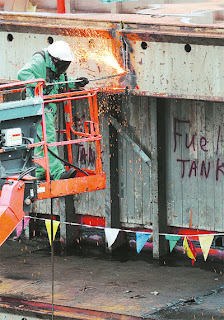 |
SS Solon Turman sits on blocks in a |
There is nothing easy -- or pretty -- about disposing of an old ship.
Call it scrapping. Or recycling. Or shipbreaking. By any name, what is taking place slowly at a dry dock at the former Mare Island Naval Shipyard in Vallejo
For the first time in decades, a decommissioned ship from the U.S. Maritime Administration's Suisun Bay Reserve Fleet is being scrapped on the West Coast. What was once the SS Solon Turman -- a 9,520-ton, 690-foot cargo ship built in 1961-- is now a shrinking cadaver.
 |
Only the ribs remain of cargo ship SS Solon Turman. (Karl Mondon/Contra Costa Times) |
Its ribs were showing last week; its bow, decks, holds and nearly all its super structure have disappeared. The tops of tanks that once contained bunker fuel to drive its massive engines were ripped off, revealing thick, black gunk that is heated to liquefy it before it is pumped away for disposal as a hazardous material.
"There's the shaft alley," said Ed Mulsoff, pointing to a long, now-exposed open space stretching from where the Turman's engine room was to its propeller. The shaft that made countless rotations during the ship's 27 years at sea is now gone.
 |
A workmen steam cleans the bunker area of the 960-foot long cargo ship, SS Solon Turman on Wednesday June 29, 2011. (Karl Mondon/Staff) |
Sections of it, cut in 20-foot lengths, sat nearby, like nearly every other part of the Turman. They will later be sold as scrap steel.
"Ninety-nine percent of it is recyclable," said Mulsoff, the dry dock superintendent for Allied Defense Recycling, the company breaking up the ship.
The Turman sat anchored in Suisun Bay
 |
A workman uses a torch to cut into a fuel bunker aboard the ship, SS Solon Turman. (Karl Mondon) |
Allied Defense Recycling was awarded a $3.1million no-bid contract to dispose of two of those ships at Mare Island
Other decommissioned ships -- some dating from World War II -- from what is commonly called the "Mothball Fleet" have been hauled, for years, to shipbreaking yards in Brownsville , Texas
 |
Crews cut the shaft of the 16-ton, stainless steel propellor of SS Solon Turman on July 5, 2011. (Karl Mondon) |
After the president is gone, there are no guarantees that others from the Suisun fleet will follow to the Vallejo
Allied now must bid for the disposal contracts, mostly against Texas
For Gary Whitney, one of Allied Defense Recycling's owners, the bidding process preoccupies most of his time, spent in a small office that contains two giant ashtrays filled with cigarette butts.
The government pays to have the ships broken. The recycling company's profits come mostly from the sale of scrap; Whitney declined to discuss what those profits might be.
Even though ships taken to Texas first must be cleaned of underwater marine growth and then towed 5,000 miles, including passage through the Panama Canal, the Gulf Coast can still prove to be a less expensive option than Vallejo
 |
Crews prepare to pull the propellor from SS Solon Turman on July 5, 2011. (Karl Mondon) |
In April, the company lost a chance to scrap four more ships -- a $2.5 million contract --when it was outbid by about $20,000, Whitney said. Despite the geographic advantage his company enjoys, vastly less expensive labor in Texas and the cost of complying with environmental regulations in California
His company now has bids in on additional vessels. No awards have been announced.
When he was in Vallejo
 |
A propeller from the cargo ship, SS Solon Turman, flies through the air as a crane carries away the 16-ton, stainless steel prop. (Karl Mondon) |
As workers continued to tear slowly toward the Turman's keel last week, the reduction of the ship that once made runs between New Orleans
Breaking down a ship the size of the Turman takes about 40,000 worker hours, or 1,666 days, Whitney said. The work started in February and should be finished in a few weeks.
Outside Whitney's office, it is easy to see why the work takes so long.
Workers with torches that spew flames as long as three feet cut down pieces of the ship that have been dumped by a crane alongside the dry dock. The pieces eventually are compressed into large containers, trucked to the Port of Oakland and shipped to a steel foundry in South Korea
For Mulsoff, who worked as a civilian employee of the Navy at Mare Island
"We built nuclear submarines from the keel up and put them in service," he said. "We refueled them. We took them out of service."
The Turman is the first ship he has dismantled.
Mulsoff stood alongside the dry dock as workers with torches cut away a section of the ship that he estimated weighed 26,000 pounds. The air was filled with the smell of acetylene. Suddenly, a horn blew from a huge crane that sits on tracks ringing the dry dock.
The crane slowly lifted the chunk of ship, then chugged along on its track, finally depositing the piece where workers could reduce it further.
The workers deep in the dry dock working on what is left of the Turman prepared to cut away another piece, then another and another.
Source: The Reporter. By Thomas Peele/ Contra Costa Times. 6 July 2011.
No comments:
Post a Comment